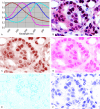Significantly higher expression levels of androgen receptor are associated with erythroblastosis virus E26 oncogene related gene positive prostate cancer
- PMID: 25374927
- PMCID: PMC4219307
Significantly higher expression levels of androgen receptor are associated with erythroblastosis virus E26 oncogene related gene positive prostate cancer
Abstract
Erythroblastosis virus E26 related gene (ERG) overexpression is correlated with the TMPRSS2-ERG fusion gene, a rearrangement known to be present in about 50% of cases of prostate cancer. Androgen receptor (AR) is a known regulator of the TMPRSS2 gene. Despite knowledge of this relationship, limited data is available on the specific relationship of AR expression to TMPRSS2-ERG fusion (ERG) status in prostate cancer (PCa). We used multiplexed immunohistochemistry, multispectral imaging technology and tissue microarray (TMA) to elucidate this relationship. Two prostate tissue microarrays were created from two cohorts of hormonal naïve patients' prostatectomy specimens: progression TMA (pTMA, from 95 PCa patients) and outcome TMA (oTMA, from 183 PCa patients with at least 5-year follow-up information). Each of the two TMAs were triple-stained with ERG, AR and E-cadherin antibodies and visualized with a different chromogen. We found marked difference in AR expression levels between ERG positive (ERG(+)) and ERG negative (ERG(-)) prostate cancer. The difference was significant in localized (pT2) prostate cancer. We also found that AR expression levels were significantly higher in PCa tissue compared to benign prostate tissue, with the highest expression levels in ERG(+) metastatic cancer. Neither AR nor ERG expression was associated with clinical outcome. Our findings confirm that TMPRSS2-ERG fusion is AR-dependent and is associated with increased AR expression. Our data suggest that the AR pathway may play an important role in the development of ERG(+) PCa and ERG status may be useful in stratifying PCa patients for hormonal therapy.
Keywords: AR; ERG; TMPRSS2; prostate cancer.
Figures



Similar articles
-
The prognostic and predictive value of TMPRSS2-ERG gene fusion and ERG protein expression in prostate cancer biopsies.Dan Med J. 2016 Dec;63(12):B5319. Dan Med J. 2016. PMID: 27910803 Review.
-
Increased androgen receptor gene copy number is associated with TMPRSS2-ERG rearrangement in prostatic small cell carcinoma.Mol Carcinog. 2015 Sep;54(9):900-7. doi: 10.1002/mc.22162. Epub 2014 Apr 29. Mol Carcinog. 2015. PMID: 24777847
-
Correlation between ERG Fusion Protein and Androgen Receptor Expression by Immunohistochemistry in Prostate, Possible Role in Diagnosis and Therapy.J Cancer. 2017 Aug 5;8(13):2604-2613. doi: 10.7150/jca.16751. eCollection 2017. J Cancer. 2017. PMID: 28900498 Free PMC article.
-
Relation of ETS transcription factor family member ERG, androgen receptor and topoisomerase 2β expression to TMPRSS2-ERG fusion status in prostate cancer.Neoplasma. 2014;61(1):9-16. Neoplasma. 2014. PMID: 24195515
-
Androgen receptor and gene network: Micromechanics reassemble the signaling machinery of TMPRSS2-ERG positive prostate cancer cells.Cancer Cell Int. 2014 Apr 17;14:34. doi: 10.1186/1475-2867-14-34. eCollection 2014. Cancer Cell Int. 2014. PMID: 24739220 Free PMC article. Review.
Cited by
-
TMPRSS2:ERG Gene Fusions in Prostate Cancer of West African Men and a Meta-Analysis of Racial Differences.Am J Epidemiol. 2017 Dec 15;186(12):1352-1361. doi: 10.1093/aje/kwx235. Am J Epidemiol. 2017. PMID: 28633309 Free PMC article.
-
Hyperspectral and multispectral imaging in digital and computational pathology: a systematic review [Invited].Biomed Opt Express. 2020 May 21;11(6):3195-3233. doi: 10.1364/BOE.386338. eCollection 2020 Jun 1. Biomed Opt Express. 2020. PMID: 32637250 Free PMC article. Review.
References
-
- Montgomery JS, Price DK, Figg WD. The androgen receptor gene and its influence on the development and progression of prostate cancer. J Pathol. 2001;195:138–146. - PubMed
-
- Cinar B, Koeneman KS, Edlund M, Prins GS, Zhau HE, Chung LW. Androgen receptor mediates the reduced tumor growth, enhanced androgen responsiveness, and selected target gene transactivation in a human prostate cancer cell line. Cancer Res. 2001;61:7310–7317. - PubMed
-
- Kasper S, Sheppard PC, Yan Y, Pettigrew N, Borowsky AD, Prins GS, Dodd JG, Duckworth ML, Matusik RJ. Development, progression, and androgen-dependence of prostate tumors in probasin-large T antigen transgenic mice: a model for prostate cancer. Lab Invest. 1998;78:319–333. - PubMed
-
- Lin B, Ferguson C, White JT, Wang S, Vessella R, True LD, Hood L, Nelson PS. Prostate-localized and androgen-regulated expression of the membrane-bound serine protease TMPRSS2. Cancer Res. 1999;59:4180–4184. - PubMed
-
- Tomlins SA, Rhodes DR, Perner S, Dhanasekaran SM, Mehra R, Sun XW, Varambally S, Cao X, Tchinda J, Kuefer R, Lee C, Montie JE, Shah RB, Pienta KJ, Rubin MA, Chinnaiyan AM. Recurrent fusion of TMPRSS2 and ETS transcription factor genes in prostate cancer. Science. 2005;310:644–648. - PubMed
LinkOut - more resources
Full Text Sources
Research Materials
